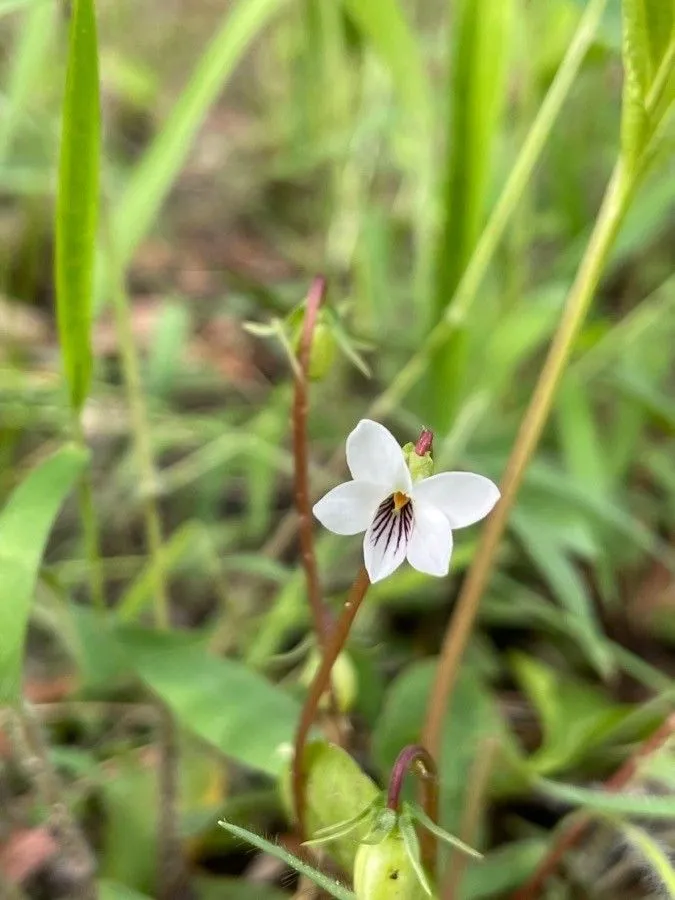
Author: L.
Bibliography: Sp. Pl.: 934 (1753)
Year: 1753
Status: accepted
Rank: species
Genus: Viola
Vegetable: Unknown
Observations: E. Canada to C. & E. U.S.A.
The Bog white violet, scientifically known as Viola lanceolata, is an enchanting perennial herbaceous plant belonging to the Violaceae family. This delicate and attractive plant was first described by the renowned botanist Carl Linnaeus in the seminal work “Species Plantarum” in 1753.
Viola lanceolata is predominantly found in the wetlands and boggy areas ranging from Eastern Canada to the Central and Eastern regions of the United States. The plant is adapted to moist, acidic soils, typically thriving in habitats like marshes, wet meadows, and shores of lakes and streams.
Characterized by its slender, lance-shaped leaves, the Bog white violet stands out due to its unique foliage, which sets it apart from other violet species. The leaves of Viola lanceolata are long and narrow, tapering to a fine point, and grow in a basal rosette, giving the plant a distinctive appearance.
In spring and early summer, the Bog white violet produces small, delicate flowers that are typically white, often with subtle blue or violet veins that guide pollinators to the center of the bloom. Each flower consists of five petals, with the lower petal usually being slightly larger and spurred, a common feature in the Viola genus.
Pollination is primarily carried out by insects, including bees and butterflies, attracted by the plant’s subtle beauty and nectar. The Bog white violet is not only a striking natural addition to wetlands but also plays a valuable role in the ecosystem by providing food and habitat for various pollinators.
Despite its seemingly fragile appearance, Viola lanceolata is a resilient species well-suited to its unique environmental niches. Garden enthusiasts interested in native plants might cultivate this species to add a touch of native allure to water gardens or other moist landscape areas.
In conservation contexts, preserving the natural habitats of the Bog white violet is crucial, as wetland areas face increasing threats from human activities and climate change. Efforts to protect wetland environments ensure that this elegant species continues to flourish and contribute to the biodiversity of its native regions.
In summary, Viola lanceolata, or the Bog white violet, is a plant of understated beauty and ecological importance, celebrated for its elegant foliage and delicate flowers. Its presence from Eastern Canada to the Central and Eastern United States marks it as a significant component of wetland ecosystems in these regions.
Eng: bog white violet, eastern water violet, lance-leaf violet, strap-leaf violet, lance-leaved violet, white bog violet, strap-leaved violet, water violet
Fra: violette lancéolée, violette élancée
En: Bog white violet, Lance-leaf violet, Eastern water violet, Strap-leaf violet, Long-leaf violet, LANCELEAF VIOLET, Howell’s Violet, Lance-leaved Violet, White bog violet, Strap-leaved violet, Water violet
Fi: Amerikanorvokki
Fr: Violette lancéolée, Violette élancée
Fa: بنفشه زوبینی
Taken Nov 15, 2012 by EOL − Bob Peterson (cc-by-sa)
Taken Mar 27, 2022 by Charles Edwards (cc-by-sa)
Taken Jun 1, 2021 by guinnevere lowe (cc-by-sa)
Taken Apr 29, 2022 by Blue Bottle (cc-by-sa)
Taken May 25, 2022 by Amber Ruczko (cc-by-sa)
Taken Jun 1, 2021 by guinnevere lowe (cc-by-sa)
Taken Jun 1, 2021 by guinnevere lowe (cc-by-sa)
Taken Jan 1, 1900 by EOL − John Hilty (cc-by-nc)
Taken May 2, 2022 by mainlymaren (cc-by-sa)
Taken Jun 1, 2021 by guinnevere lowe (cc-by-sa)
Taken Apr 11, 2016 by EOL − anewman (cc-by-nc)
Taken Jan 1, 1900 by EOL − Cooper, G.A. (cc-by-nc-sa)
Taken Mar 8, 2012 by EOL − Jason Sharp (cc-by-nc-sa)
Taken Jan 1, 1900 by EOL − John Hilty (cc-by-nc)
Taken Jan 1, 1900 by EOL − Smithsonian Institution, National Museum of Natural History, Department of Botany (cc-by-nc-sa)
Family: Myrtaceae Author: (F.Muell.) K.D.Hill & L.A.S.Johnson Bibliography: Telopea 6: 402 (1995) Year: 1995 Status:…
Family: Rubiaceae Author: Pierre ex A.Froehner Bibliography: Notizbl. Bot. Gart. Berlin-Dahlem 1: 237 (1897) Year:…
Family: Sapindaceae Author: Koidz. Bibliography: J. Coll. Sci. Imp. Univ. Tokyo 32(1): 38 (1911) Year:…
Family: Asteraceae Author: A.Gray Bibliography: Pacif. Railr. Rep.: 107 (1857) Year: 1857 Status: accepted Rank:…
Family: Fabaceae Author: Medik. Bibliography: Vorles. Churpfälz. Phys.-Ökon. Ges. 2: 398 (1787) Year: 1787 Status:…
Family: Aspleniaceae Author: (Cav.) Alston Bibliography: Bull. Misc. Inform. Kew 1932: 309 (1932) Year: 1932…